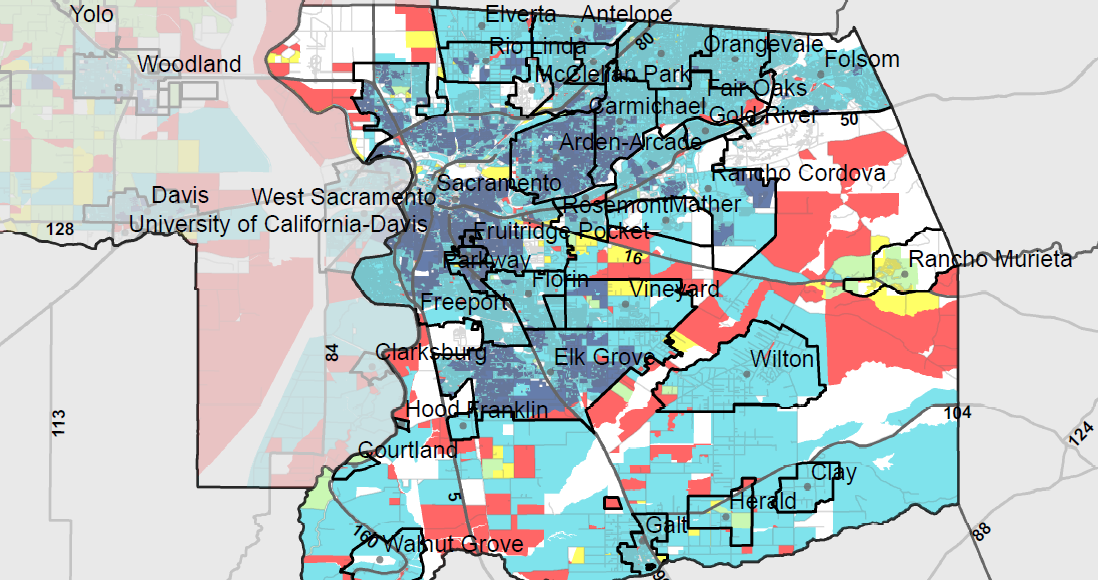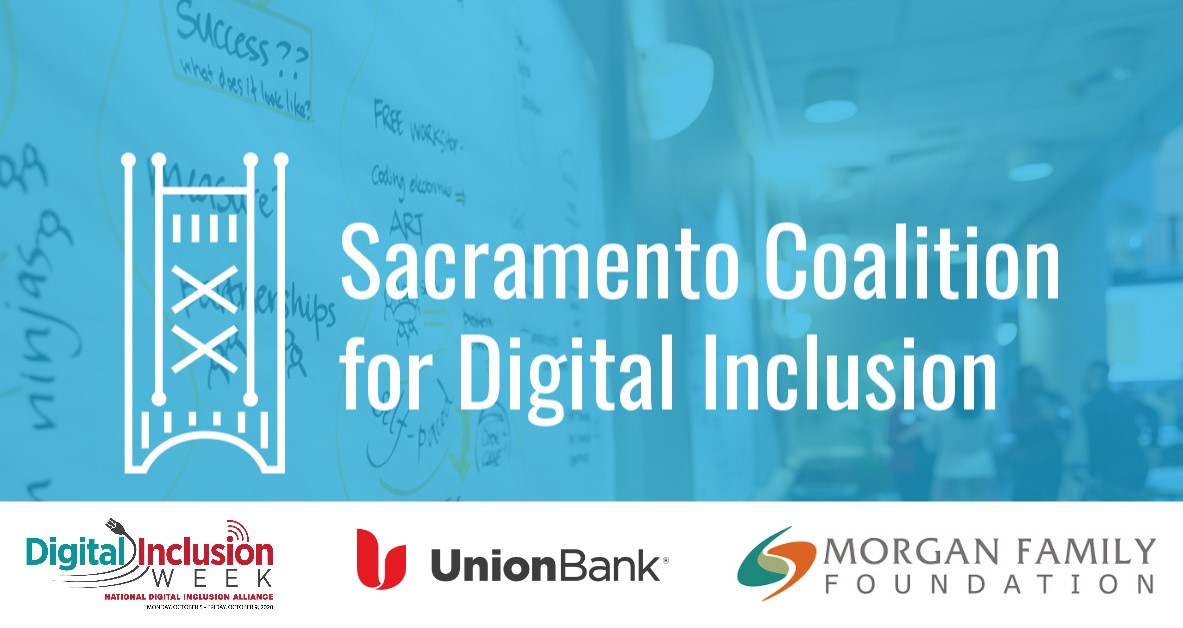Policy Brief: Internet Service Competition in CA and the Capital Region (2021)

This policy brief presents an analysis of the internet service market and providers choices (number of ISPs) serving residential customers in California and the Connected Capital Area Broadband Consortium (CCABC) Region, and its implications on cost and quality of service.
This analysis is based on broadband availability data from the California Public Utilities Commission from 2020 (as of December 2019). Findings of our analysis are that in California, the vast majority of the population (near 87%), households, and housing units, have access to two or less choices of ISPs, which indicates a concentrated and non-competitive market. Furthermore, analyzing the number of internet choices, in areas served at different speed standards, nearly all population (high nineties percent) have access to two or less choices of ISPs.
Preferred Scenario for Unserved Households in the CCABC Region (2021)
Valley Vision, as manager of the Connected Capital Area Broadband Consortium (CCABC) (funded by the CPUC CASF Program), partnered with the California Emerging Technology Fund (CETF) to prepare the “Preferred Scenario for Unserved Households in the CCABC Region.”
This report provides detailed information on 1) identifying unserved households at different broadband standards in the Capital Region, 2) estimating the deployment costs to connect these unserved households, and 3) establishing partnerships with state agencies and broadband stakeholders to achieve cost-efficient infrastructure deployments. It also incorporates demand aggregation of potential community anchor institutions and business customers to ensure a sustainable business model for ISPs in the long term.
The Preferred Scenarios Report will help local governments, ISPs, and broadband stakeholders to accelerate broadband expansion and upgrades in the Capital Region to achieve affordable, reliable, and high-speed Broadband for All.
Launch Event – Getting Connected: A Broadband Resource Guide

Valley Vision, together with the California Emerging Technology Fund and California Forward, invite you to the statewide launch of “Getting Connected: A Broadband Deployment and Adoption Resource Guide for Local and Regional Government Leaders,” on Friday, May 14, from 10 AM to 12 PM.
The Guide provides detailed information and resources on innovative policies and practices to accelerate broadband investment at the local and regional levels, highlighting examples of best practices, toolkits and information resources from communities across the state and nationally. The Guide will help us reach our goal of high speed Internet connectivity and Broadband for All.
The webinar will include a presentation of the results of a statewide survey on the digital divide, an overview of the Guide, and a three-person panel to spotlight some of the innovative models and best practices found in the Guide.
Getting Connected: A Broadband Resource Guide (2021)
The California Emerging Technology Fund partnered with Valley Vision to prepare the new “Getting Connected: A Broadband Deployment and Adoption Resource Guide for Local and Regional Government Leaders.” This is the first update since the original guide was prepared ten years ago and much has changed since then. While progress has been made to address the Digital Divide, Covid-19 Pandemic exposed the stark and growing gaps within and across our communities related to Digital Equity and Inclusion.
The Resource Guide provides detailed information and resources on innovative policies and practices to accelerate broadband investment at the local and regional levels, highlighting examples of best practices, toolkits and information resources from communities across the state and nationally. The Resource Guide will help us reach our goal of high speed Internet connectivity and Broadband for All. Click here to view the joint letter from Valley Vision and the California Emerging Technology Fund announcing the launch of the Resource Guide.
A launch event was held in partnership with California Forward on Friday, May 14th. Click here to view the recording. The event also featured a presentation of the results of a statewide survey on the digital divide, an overview of the Guide, and a three-person panel to spotlight some of the innovative models and best practices found in the Guide. You can view the slides covering these items below:
Webinar #1 – May 15, 2021 – Recording
Webinar #2 – June 15, 2021
Webinar #3 – August 26, 2021
Policy Brief: How Much Broadband Speed Do You Need? (2020)

Valley Vision, as the managing organization for the Connected Capital Area Broadband Consortium (CCABC), has prepared this policy brief. The CCABC is funded by the California Public Utilities Commission (CPUC) and supports the counties of Sacramento, Sutter, Yolo and Yuba to achieve improved internet connectivity across the region and reduce the Digital Divide.
This policy brief was prepared due to the critical need to expand connectivity, as the pandemic revealed the disparities across the region – connectivity essential for both recovery and an inclusive community. The brief ties together different aspects of internet use from household needs (i.e., speed, usage, multiple users’ needs, and technologies), to larger regional deployment and cost analysis (i.e., broadband coverage by technology and cost to bring internet to unserved households).
Broadband Coverage in the Delta (October 2020)
Beginning in 2014, the Delta Protection Commission (Commission) undertook the Delta Community Action Planning (CAP) project to increase civic vitality and preserve the values and character of historic Delta towns. Through the CAP process, broadband infrastructure was identified as an essential utility needed to serve residents, businesses (including agricultural operations), and visitors. In 2019, Valley Vision completed Connecting the Delta: Broadband Action Plan, a report prepared for the Commission to inform local governments and all those affected by the lack of high-speed internet service of recommended actions to improve broadband adoption and support.
According to the report, within the five legacy communities identified in the CAP project (Clarksburg, Courtland, Hood, Isleton, and Walnut Grove), approximately one-third of households did not have Internet subscriptions at the time of report preparation in 2019. Households and businesses within the legacy communities have very limited provider options. Additionally, 17% of households within Delta communities do not have access to a computing device (desktop, laptop, smartphone, or tablet). Access, quality, reliability, and cost all factor into this circumstance. The Delta is faced with many barriers and has several unserved and underserved areas lacking broadband service, compared to the surrounding greater metropolitan areas of Sacramento, Stockton-Tracy, and the San Francisco Bay Area.
At broadband workshops held in the Delta during 2018 and 2019, community members voiced broadband quality and access frustrations, equity discrepancies, and educational and safety concerns. Additionally, while not exclusive to broadband, it must be noted that each community also identified challenges with mobile wireless (i.e. cell phones) and lack of signal availability.
The 2019 action plan offered three recommendations for achieving improved broadband: (1) organize for action; (2) leverage existing opportunities; and (3) pursue and secure funding. As a preliminary step to organizing for action, the Commission is partnering with Valley Vision and the Connected Capital Area Broadband Consortium (CCABC) to assess the broadband coverage in the five legacy communities and an expanded area including Bethel Island, the Delta Loop, Freeport, Rio Vista, and Terminous.
The following report and maps will be used in three ways:
- To provide local governing bodies, committees, and councils the coverage profiles that broadband service providers have reported to the CPUC,
- To kick off a campaign to engage residents of these Delta communities to test and register their actual residential service download and upload speeds for comparison with the reported available speeds, and
- After reviewing testing results, identify areas where service most needs improvement, and work with the community leaders, appropriate broadband coalitions, Internet service providers and the CPUC to leverage existing opportunities for service improvement and seek funding support.
Sacramento Area Broadband Coverage Maps (CPUC 2019 Data)

These maps from the CA Public Utilities Commission (CPUC) illustrate broadband coverage across the 4-county Connected Capital Area Broadband Consortium (CCABC) area. The CPUC collects reports from providers throughout the state. More data is available through the agency’s interactive broadband map.
High-Resolution Maps:
- City of Sacramento Broadband Coverage (CPUC 2019 Data)
- City of Sacramento Broadband Coverage – Satellite (CPUC 2019 Data)
- County of Sacramento Broadband Coverage (CPUC 2019 Data)
- County of Sacramento Broadband Coverage – Satellite (CPUC 2019 Data)
- County of Sutter Broadband Coverage (CPUC 2019 Data)
- County of Sutter Broadband Coverage – Satellite (CPUC 2019 Data)
- County of Yolo Broadband Coverage (CPUC 2019 Data)
- County of Yolo Broadband Coverage – Satellite (CPUC 2019 Data)
- County of Yuba Broadband Coverage (CPUC 2019 Data)
- County of Yuba Broadband Coverage – Satellite (CPUC 2019 Data)
Getting Connected in the Capital Region (2020)
Accelerating broadband infrastructure investment has never been more urgent. Ubiquitous broadband is indispensable to our region’s recovery and resilience in the wake of the COVID-19 pandemic.
On Thursday, October 1, Valley Vision, the California Emerging Technology Fund (CETF), and the Sacramento Area Council of Governments (SACOG) virtually co-convened broadband partners and stakeholders to discuss how to accelerate broadband infrastructure investments across the region. The event also launched highlights of “Getting Connected,” a resource guide for local and regional government leaders to deploy 21st century broadband infrastructure. As manager of the CPUC-funded Connected Capital Area Broadband Consortium (CCABC), Valley Vision partnered with CETF on preparing this leading-edge resource guide, which features best practices, policies, and innovative models to accelerate broadband infrastructure investment and adoption.
Meeting Materials:
Sacramento Coalition for Digital Inclusion Meeting: October 2020

The Sacramento Coalition for Digital Inclusion consists of more than 40 organizations and is led by a steering committee comprised of the City of Sacramento, the Sacramento Public Library, Sacramento City College, Los Rios Community College District, California State University Sacramento, and Valley Vision. Valley Vision secured short term funding to relaunch the Coalition through the Morgan Family Foundation and Union Bank.
The Sacramento Coalition for Digital Inclusion had its 2020 relaunching meeting on September 18th (see meeting notes here). The steering committee and members presented on current broadband topics which first, elevated the critical issues related to digital inclusion in the community, and second, enabled a collaboration path forward. The Coalition is working on three main areas or subgroups:
- Internet Access and Adoption
- Technology Devices
- Digital Literacy/Digital Skills
Join us at the next Coalition meeting on October 23rd 11am to 12:30pm. RSVP here: https://us02web.zoom.us/meeting/register/tZ0kc-yoqDoqG9HsbBR8DsKmYluIRGvSumu4
For more information on the Sacramento Coalition for Digital Inclusion, visit https://digitalinclusionsac.org/. Stay tuned for our new website in the coming weeks!
Broadband Report Card: Map (2020)
Broadband infrastructure grades compare broadband access in a city, town, region, county, or census block to the California average. These maps illustrate the data found in the capital region broadband report card. Click here for grades for each jurisdiction in the Sacramento region.
Steve Blum with Tellus Venture Associates assembled this information on behalf of Valley Vision, as part of the latter’s work in managing the Connected Capital Broadband Consortium (CCABC).
The primary data for assessing the quantity and quality of broadband infrastructure comes from the California Public Utilities Commission (CPUC), which collects reports from providers throughout the state. More data is available through the interactive broadband map produced by the CPUC.
Broadband Report Card: Grades (2020)
Broadband infrastructure grades compare broadband access in a city, town, region, county, or census block to the California average.
Steve Blum with Tellus Venture Associates assembled this information on behalf of Valley Vision, as part of the latter’s work in managing the Connected Capital Broadband Consortium (CCABC).
The primary data for assessing the quantity and quality of broadband infrastructure comes from the California Public Utilities Commission (CPUC), which collects reports from providers throughout the state. More data is available through the interactive broadband map produced by the CPUC.
Preferred Broadband Scenarios

In the digital age, fast and reliable internet is indispensable to equity and economic development. Without it, community members are barred from full access to basic services, job opportunities, among other tools and paths for improving quality of life.
Valley Vision is at the center of strategic efforts to improve broadband access in California’s Capital Region, paving the way for future-ready infrastructure and regional prosperity.
Under a grant from the California Emerging Technology Fund, Valley Vision put together a Preferred Scenario that identifies gaps in broadband deployment and access throughout the Capital Region, and the available local assets to address these gaps. Valley Vision is also convening local governments to discuss best practices at the local level for addressing this issue.